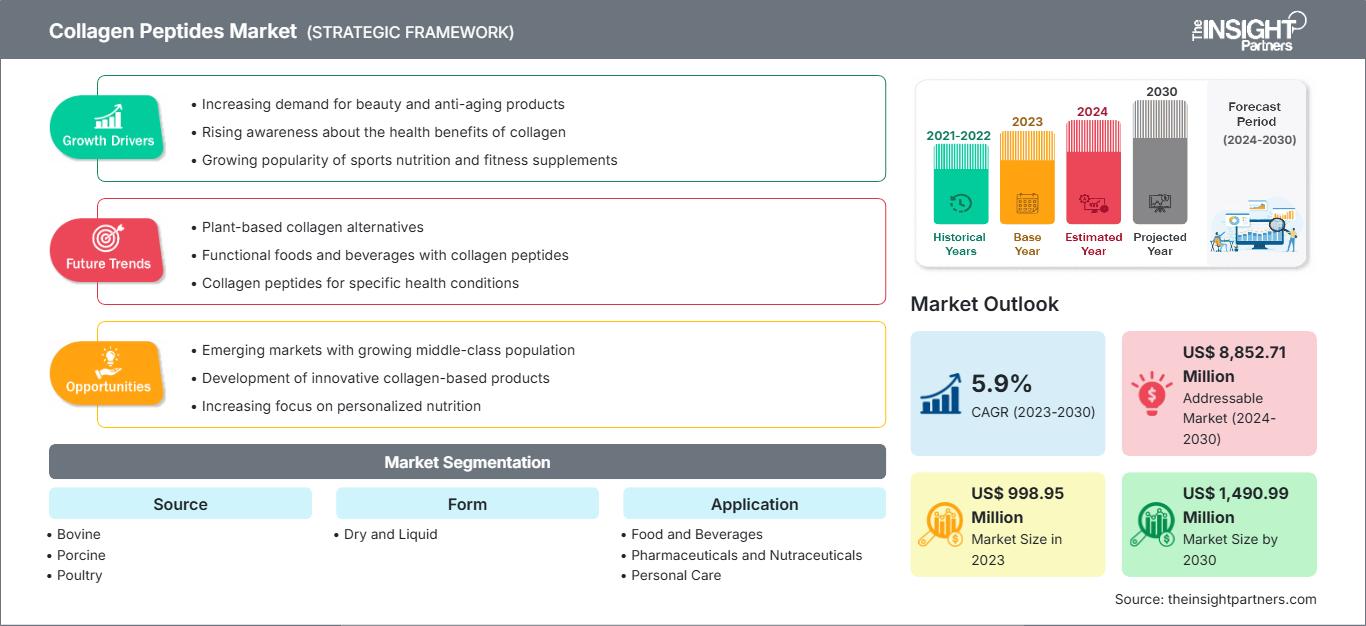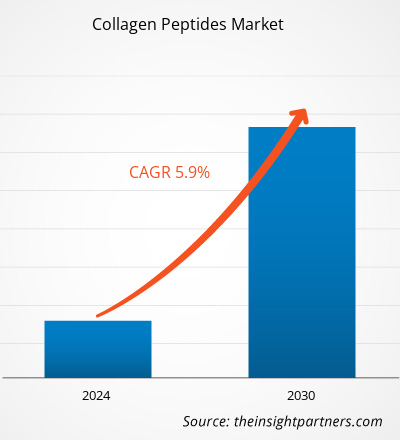[Forschungsbericht]Der Markt für Kollagenpeptide wurde im Jahr 2023 auf 998,95 Millionen US-Dollar geschätzt und soll bis 2030 1.490,99 Millionen US-Dollar erreichen; von 2023 bis 2030 wird eine durchschnittliche jährliche Wachstumsrate (CAGR) von 5,9 % erwartet.
Der globale Markt für Kollagenpeptide ist hart umkämpft. Zahlreiche lokale, regionale und globale Hersteller konkurrieren um Produktqualität und Innovation. Einige Hersteller von Kollagenpeptiden haben Koscher- und Halal-Zertifizierungen erhalten und stärken so ihre Wettbewerbsposition auf dem Weltmarkt. So verfügt beispielsweise Rousselot, einer der bedeutendsten Kollagenhersteller, über Halal- und Koscher-zertifizierte Produktionseinheiten. Darüber hinaus ist das Unternehmen nach IFS, ISO 9001, GMP+ und FCA zertifiziert und stärkt so seine Marktposition. Hersteller investieren zudem in Produktinnovation und Neuproduktentwicklung, um den sich ändernden Kundenwünschen gerecht zu werden. So hat beispielsweise Evonik Industries Inc. kürzlich veganes Kollagen auf den Markt gebracht, das durch Fermentation hergestellt wird. Diese Initiative dürfte Herstellern auf dem globalen Markt für Kollagenpeptide lukrative Möglichkeiten bieten.
Im Jahr 2022 hatte Nordamerika den größten Anteil am globalen Markt für Kollagenpeptide, und der asiatisch-pazifische Raum wird im Prognosezeitraum voraussichtlich die höchste durchschnittliche jährliche Wachstumsrate verzeichnen. Kollagenpeptide werden in verschiedenen Nahrungsergänzungsmitteln wie Pulver, Kapseln, Tabletten und Gummibärchen verwendet. Die hohe Nachfrage nach Nutrazeutika in der Region treibt den Absatz von Kollagenpeptiden maßgeblich an. Daher greift die Nutrikosmetikindustrie zunehmend auf Kollagenpeptide zurück, um die Anforderungen der Verbraucher zu erfüllen. Darüber hinaus sind Kollagenpeptide wirksam bei Knochenschwund, Verlust der Knochendichte und -stabilität. Daher treibt das breite Anwendungsspektrum die Nachfrage nach Kollagenpeptiden in der gesamten Region an.
Passen Sie diesen Bericht Ihren Anforderungen an
Sie erhalten kostenlos Anpassungen an jedem Bericht, einschließlich Teilen dieses Berichts oder einer Analyse auf Länderebene, eines Excel-Datenpakets sowie tolle Angebote und Rabatte für Start-ups und Universitäten.
Markt für Kollagenpeptide: Strategische Einblicke

-
Holen Sie sich die wichtigsten Markttrends aus diesem Bericht.Dieses KOSTENLOSE Beispiel umfasst Datenanalysen, die von Markttrends bis hin zu Schätzungen und Prognosen reichen.
Auswirkungen der COVID-19-Pandemie auf den Markt für Kollagenpeptide
Der steigende Konsum von funktionellen Lebensmitteln und Getränken, Nahrungsergänzungsmitteln und die hohe Nachfrage nach proteinreichen Produkten sind die Hauptfaktoren, die das Wachstum des Marktes für Kollagenpeptide vor dem Ausbruch der COVID-19-Pandemie beflügelten. Nach dem Ausbruch im Jahr 2020 standen diese Branchen jedoch vor beispiellosen Herausforderungen.
Im Jahr 2021 nahmen verschiedene Volkswirtschaften ihre Produktion wieder auf, da die Regierungen mehrerer Länder Lockerungen der zuvor verhängten Beschränkungen ankündigten, was den globalen Markt ankurbelte. Darüber hinaus durften die Hersteller mit voller Kapazität arbeiten, was ihnen half, die Lücke zwischen Angebot und Nachfrage sowie andere Auswirkungen zu überwinden. Da zahlreiche Bürger vieler Länder bis 2021 vollständig geimpft waren, konzentrierten sich die Hersteller von Kollagenpeptiden auf die Steigerung ihrer Produktion, um ihre Geschäfte wiederzubeleben.
Markteinblicke
Steigende Nachfrage nach Kollagenpeptiden aus dem Meer fördert das Wachstum des Marktes für Kollagenpeptide
Meeresorganismen wie Fische, Quallen, Schwämme und andere wirbellose Tiere sind eine bedeutende Quelle für Kollagenpeptide. Sie sind gegenüber anderen Quellen äußerst vorteilhaft, da sie metabolisch kompatibel sind, keinen religiösen Einschränkungen unterliegen und frei von tierischen Pathogenen sind. Darüber hinaus können Kollagenpeptide aus dem Meer aufgrund ihrer Wasserlöslichkeit und metabolischen Kompatibilität als Biomaterial verwendet werden. Daher steigt die Nachfrage nach Kollagenpeptiden aus dem Meer mit der zunehmenden Nutzung für verschiedene industrielle Anwendungen.
Darüber hinaus fördern Kollagenpeptide aus dem Meer keine übertragbaren Krankheiten. Landtiere sind anfällig für viele übertragbare Krankheiten, was sie für die industrielle Nutzung weniger geeignet macht. Rinder beispielsweise sind zwar eine wichtige Kollagenquelle, bergen aber ein Risiko für BSE und TSE. Diese Faktoren machen marine Quellen für Kollagenpeptide zu einer deutlich einfacheren, sichereren und vielversprechenderen Alternative. Mit der steigenden Nachfrage bringen Hersteller daher verschiedene Produkte auf den Markt. So brachte Darling Ingredients im Januar 2021 unter seiner Marke Rousselot Peptan auf den Markt, ein marines Kollagenpeptid. Dieses Produkt ermöglicht dem Unternehmen den Einstieg in den Markt für Nahrungsergänzungsmittel. Daher wird erwartet, dass die steigende Nachfrage nach Kollagen marinen Ursprungs im Prognosezeitraum neue Möglichkeiten auf dem Markt für Kollagenpeptide eröffnen wird.
Quellenbasierte Erkenntnisse
Basierend auf der Quelle ist der Markt für Kollagenpeptide in Rind-, Schweine-, Geflügel-, Meeres- und sonstige Quellen unterteilt. Das Rindersegment hielt 2022 den größten Marktanteil, während das Meeressegment im Prognosezeitraum das schnellste Wachstum verzeichnete. Marine Kollagenpeptide werden hauptsächlich aus verschiedenen Fischarten, Quallen und Schwämmen gewonnen. Daher steigt die Nachfrage nach marinen Kollagenpeptiden als Ersatz für Rinder- und Schweinekollagenpeptide, was sich voraussichtlich auf das Marktwachstum für Kollagenpeptide auswirken wird.
Anwendungsbasierte Erkenntnisse
Basierend auf der Anwendung ist der Markt für Kollagenpeptide in Lebensmittel und Getränke, Pharmazeutika und Nutrazeutika, Körperpflege und Sonstiges unterteilt. Das Segment Lebensmittel und Getränke wird im Prognosezeitraum voraussichtlich die höchste durchschnittliche jährliche Wachstumsrate verzeichnen. In Milchprodukten wird es als Texturierungs- und Stabilisierungsmittel verwendet. Kollagenhydrolysate können Calciumionen binden und so ihre Bioverfügbarkeit verbessern. Daher können Kollagenpeptide in funktionellen Lebensmittelzutaten verwendet werden, um Mineralstoffmangel zu beheben.
Kollagenpeptide können für Lebensmittel nützlich sein, die bei kalten oder Gefriertemperaturen gelagert werden müssen, da sie als Antikoagulans wirken und helfen, Zell- und Gewebeschäden zu verringern. Kollagenpeptide helfen, die sensorischen, physikalischen und chemischen Eigenschaften des Produkts zu verbessern und zu erhalten. Aufgrund der oben genannten Eigenschaften werden Kollagenpeptide daher zur Herstellung verschiedener Produkte wie Fleisch, Getränken und Suppen verwendet.
Die wichtigsten Akteure auf dem Markt für Kollagenpeptide sind GELITA AG, Rousselot BV, Titan Biotech Ltd, Tessenderlo Group NV, Ewald-Gelatine GmbH, BioCell Technology LLC, Lapi Gelatine SpA, Weishardt Holding SA, Nippi Collagen NA Inc und Nitta Gelatin India Ltd. Diese Unternehmen konzentrieren sich auf die Einführung neuer Produkte und die geografische Expansion, um die weltweit wachsende Verbrauchernachfrage zu befriedigen und ihr Produktangebot in Spezialportfolios zu erweitern. Sie verfügen über eine weitverbreitete globale Präsenz, die es ihnen ermöglicht, einen großen Kundenstamm zu bedienen und so ihren Marktanteil zu erhöhen.
Markt für Kollagenpeptide
Die Analysten von The Insight Partners haben die regionalen Trends und Faktoren, die den Markt für Kollagenpeptide im Prognosezeitraum beeinflussen, ausführlich erläutert. In diesem Abschnitt werden auch die Marktsegmente und die geografische Verteilung von Kollagenpeptiden in Nordamerika, Europa, im asiatisch-pazifischen Raum, im Nahen Osten und Afrika sowie in Süd- und Mittelamerika erläutert.Umfang des Marktberichts über Kollagenpeptide
| Berichtsattribut | Einzelheiten |
|---|---|
| Marktgröße in 2023 | US$ 998.95 Million |
| Marktgröße nach 2030 | US$ 1,490.99 Million |
| Globale CAGR (2023 - 2030) | 5.9% |
| Historische Daten | 2021-2022 |
| Prognosezeitraum | 2024-2030 |
| Abgedeckte Segmente |
By Quelle
|
| Abgedeckte Regionen und Länder |
Nordamerika
|
| Marktführer und wichtige Unternehmensprofile |
|
Dichte der Marktteilnehmer für Kollagenpeptide: Verständnis ihrer Auswirkungen auf die Geschäftsdynamik
Der Markt für Kollagenpeptide wächst rasant. Die steigende Nachfrage der Endverbraucher ist auf Faktoren wie veränderte Verbraucherpräferenzen, technologische Fortschritte und ein stärkeres Bewusstsein für die Produktvorteile zurückzuführen. Mit der steigenden Nachfrage erweitern Unternehmen ihr Angebot, entwickeln Innovationen, um den Bedürfnissen der Verbraucher gerecht zu werden, und nutzen neue Trends, was das Marktwachstum weiter ankurbelt.
- Holen Sie sich die Markt für Kollagenpeptide Übersicht der wichtigsten Akteure
Bericht-Spotlights
- Fortschreitende Branchentrends im Markt für Kollagenpeptide, die Unternehmen bei der Entwicklung effektiver langfristiger Strategien unterstützen
- Geschäftswachstumsstrategien der Marktteilnehmer in Industrie- und Entwicklungsländern
- Quantitative Analyse des Marktes von 2022 bis 2030
- Schätzung der weltweiten Nachfrage nach Kollagenpeptiden
- Porters Fünf-Kräfte-Analyse zur Veranschaulichung der Wirksamkeit von Käufern und Lieferanten im Markt für Kollagenpeptide
- Neueste Entwicklungen zum Verständnis des wettbewerbsorientierten Marktszenarios
- Markttrends und -aussichten sowie Wachstumstreiber und -hemmnisse im Markt für Kollagenpeptide
- Unterstützung im Entscheidungsprozess durch Hervorhebung von Marktstrategien, die das kommerzielle Interesse untermauern
- Größe des Marktes für Kollagenpeptide an verschiedenen Knotenpunkten
- Ein detaillierter Überblick und die Dynamik der Kollagenpeptide-Branche
- Größe des Markt für Kollagenpeptide in verschiedenen Regionen mit vielversprechenden Wachstumschancen
- Historische Analyse (2 Jahre), Basisjahr, Prognose (7 Jahre) mit CAGR
- PEST- und SWOT-Analyse
- Marktgröße Wert/Volumen – Global, Regional, Land
- Branchen- und Wettbewerbslandschaft
- Excel-Datensatz
Aktuelle Berichte
Erfahrungsberichte
Grund zum Kauf
- Fundierte Entscheidungsfindung
- Marktdynamik verstehen
- Wettbewerbsanalyse
- Kundeneinblicke
- Marktprognosen
- Risikominimierung
- Strategische Planung
- Investitionsbegründung
- Identifizierung neuer Märkte
- Verbesserung von Marketingstrategien
- Steigerung der Betriebseffizienz
- Anpassung an regulatorische Trends






















 Kostenlose Probe anfordern für - Markt für Kollagenpeptide
Kostenlose Probe anfordern für - Markt für Kollagenpeptide